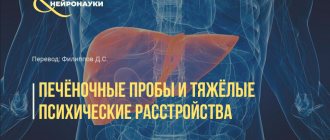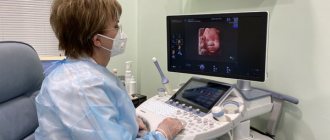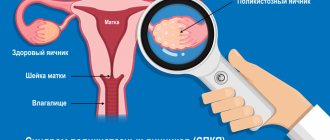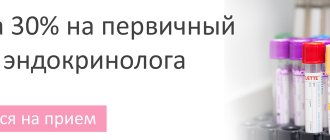The hormone estradiol is the main and most active among all estrogens. In the female body, it is responsible for regulating reproductive function and, together with progesterone, is responsible for the preservation and normal course of pregnancy. In women, it is synthesized in the ovaries, membrane and granulosa cells of the follicles, as a result of which estradiol is the main marker of their functioning. In men, it is produced by the testes and adrenal glands. Even a slight hormonal imbalance can significantly affect health, especially the reproductive system. Therefore, it is strongly recommended to study the concentration of this hormone at least once a year. This article will help you find out what estradiol is responsible for , why you need to control its concentration, the consequences of increasing or decreasing normal values.
What is the hormone estradiol responsible for?
Knowing what the hormone estradiol is responsible for in women , there is no doubt about its importance and significant impact on the functioning of all internal organs and systems of the body. It has a significant impact on the following functions:
- Reproductive function - promotes fertility, is responsible for normalizing the menstrual cycle. This hormone prepares the female body for pregnancy and bearing a child: restructuring the uterine mucosa, stimulating contraction of the fallopian tubes, and penetration of the sperm into the egg for fertilization.
- Heart and blood vessels - before menopause, estradiol in women is responsible for the elasticity and strength of blood vessels. It normalizes the concentration of cholesterol in the blood and is involved in preventing the development of inflammation.
- Bones - affects the synthesis, destruction and redistribution of osteocytes (bone cells). In this regard, after 40 years, bone fragility increases in women.
- Skin - stimulates the synthesis of collagen and hyaluronic acid. Thanks to this, the skin acquires healthy density, tone, becomes moisturized and has protection against photoaging.
- Brain - indirectly participate in the formation of connections between neurons (cells of the nervous system). Therefore, they affect concentration, memory, intelligence, and the normal cycle of sleep and wakefulness.
Hormones affecting the menstrual cycle
In order for a woman to continue her race, gonadotropic hormones are necessary. They are produced by cells of the anterior pituitary gland and include FSH, prolactin and luteinizing hormone.
FSH is responsible for the process of follicle growth in the ovary in women and sperm maturation in men. In the female body, follicle-stimulating hormone influences the conversion of testosterones into estrogens, the production of estrogens, and also the maturation of the egg.
Depending on the changes occurring in the female body, there are several phases of the menstrual cycle, during which the levels of sex hormones change:
- Follicular phase - its duration is individual for each woman, but on average it is 2 weeks (with a cycle duration of 28 days). During this phase, the follicle matures and the endometrial layer prepares to receive a fertilized egg.
- The ovulatory phase is characterized by the ripening and rupture of the dominant follicle, from which an egg ready for fertilization emerges. It moves through the fallopian tube and if a sperm is encountered on its way, fertilization occurs and pregnancy occurs. During the ovulatory phase, the level of FSH and luteinizing hormone in a woman’s body increases significantly. The duration of the ovulatory phase is approximately 5 days.
- Luteal phase - Graaffian vesicle turns into an endocrine gland for some time and progesterone or the so-called corpus luteum is intensively produced in the woman’s body. Progesterone is necessary for the successful attachment of the fertilized egg to the wall of the uterus if fertilization has occurred. If pregnancy does not occur, the level of progesterone and LH gradually decreases, which causes the development of changes in the vessels of the thickened endometrium, it is rejected and menstruation occurs.
Estradiol in men
Normally, estradiol in men is formed due to the peripheral conversion of testosterone in adipose tissue. Its excessive synthesis can cause suppression of FSH production by the pituitary gland, resulting in insufficient spermatogenesis. To diagnose an increased concentration of this hormone in medical practice, the T/E coefficient is used, which should not exceed 10. However, its insufficient synthesis also causes the development of various pathologies, since it takes part in:
- Sperm production.
- Increased processes of calcium deposition in bones.
- Improved regulation of nervous tissue.
- Metabolism stimulation.
- Strengthening oxygen exchange.
- Increased blood clotting.
- Reducing the risk of developing cardiovascular pathologies.
The estadiol norm in men varies depending on age:
| Age | Normal values, pmol/l |
| 0—12 months | <86 |
| 1 year—5 years | <84 |
| 5-10 years | <69 |
| 10-14 years | <113 |
| 14-18 years old | <182 |
| 18 years and older | 40—161 |
Estradiol in medications
Most combined oral contraceptives are based on the “beauty hormone”. Under no circumstances should you “prescribe” hormonal contraception to yourself. Self-medication with “female hormone” can cause unpleasant consequences:
- headache;
- dizziness;
- sudden mood swings;
- disturbances in liver function;
- the appearance of gallstones;
- overweight;
- vaginal bleeding.
Estradiol is a hormone that is used in the treatment of:
- insufficient development of the genital organs;
- absence of menstruation for more than 6 months;
- osteoporosis;
- increased sweating (due to hormonal imbalances).
The doctor should prescribe treatment with hormonal drugs only after tests. For liver diseases, during pregnancy and breastfeeding, such drugs are not prescribed.
Estradiol in women
When thinking about what estradiol is responsible for in women , it is worth recalling that it performs about 400 functions in the female body. With its help, the formation of secondary sexual characteristics, the development of the uterus and fallopian tubes, vagina and mammary glands occurs. This hormone has a beneficial effect on the condition of the entire body, providing:
- Synthesis of serotonin, which is responsible for a positive mood and improved memory.
- Synthesis of collagen necessary for healthy hair growth and skin elasticity.
- Limit metabolism and normalization of cholesterol in blood vessels.
- Deposition of adipose tissue according to the female type, forming an anatomically correct figure.
- Calcium retention, which helps strengthen bones.
- Normalization of blood pressure.
- Thermoregulation.
Estradiol norm in women directly depends on age:
| Age | Normal values, pg/ml |
| 2-3 years | 0—22 |
| 4-6 years | 22 |
| 7-12 years | 22—30 |
| 13—45 years | 57—480 |
| 45 years and older | 18—138 |
Reasons for deviations from the norm in women - what to do?
Causes of low estradiol:
- low body mass index;
- stress;
- menopause;
- genetic disorders;
- hyperprolactinemia;
- hypopituitarism.
Low estradiol levels can be increased with proper nutrition. A woman is advised to reduce the amount of fat and carbohydrates she consumes. The emphasis should be on dishes with a high content of complete protein and fiber. You need to include vegetables, fruits, legumes, flax seeds, liver, and dairy products in your diet.
Hormonal therapy should be carried out under medical supervision. Only a specialist can correctly select a drug that will compensate for the hormone deficiency. The most commonly prescribed medications are Premarin, Progenova, and Hemafemin.
Alternative medicine can also help increase estradiol levels in women. A good effect is achieved by using decoctions of raspberry leaves, sage, clover, and plantain seeds.
Causes of elevated estradiol:
- polycystic ovary syndrome;
- ovarian tumors;
- neoplasms in the mammary glands;
- hyperthyroidism;
- obesity;
- chronic form of alcoholism.
If estradiol is elevated, it is recommended to eat foods containing protein and Omega-3. Preference should be given to plant foods. Herbal preparations based on boron uterus and red brush effectively reduce the concentration of the hormone.
To restore hormone balance, it is necessary to normalize weight.
Why is an estradiol test necessary?
This blood test is a basic test to assess the condition of the female body. With its help, it is possible to most reliably determine the state of the ovaries during the menstrual cycle, and it is possible to control the induction of ovarian ovulation. It is also an important diagnostic sign for the following pathological conditions:
- Infertility (both men and women).
- Hyper- and hypoestrogenism with clinical symptoms.
- Tumor of hormonal etiology in men.
As a rule, this analysis is prescribed in combination with other hormones. Gynecologists recommend donating blood on days 3-5 of the menstrual cycle for women and at any time for men.
Estradiol (E2)
What is estradiol (E2, Estradiol)?
It is the most active estrogenic (female) sex steroid hormone. From a biosynthetic point of view, estradiol is a derivative of cholesterol, and its immediate precursors are androstenedione and testosterone. In women, it is produced in the ovaries, placenta and adrenal cortex under the influence of follicle-stimulating hormone (FLH), luteinizing hormone (LH) and prolactin. Estradiol is formed in small quantities during the conversion of testosterone. Estradiol ensures the formation of the reproductive system according to the female type, the development of female secondary sexual characteristics in adolescence, the regulation of the menstrual cycle, the development of the egg, the growth and development of the uterus during pregnancy, is responsible for the psychophysiological characteristics of sexual behavior, and ensures the formation of subcutaneous fatty tissue according to the female type. The main effect is to cause increased growth of cells lining the uterus from the inside, which prepares it for pregnancy and, by reducing the resistance of the uterine vessels, increases blood flow in it. In women of childbearing age, the level of estradiol in serum and blood plasma depends on the phase of the menstrual cycle. At the beginning of the cycle, the concentration of estradiol slowly increases. The highest levels of estradiol are observed at the end of the follicular phase - before ovulation. Ovulation (rupture of the follicle and release of the egg) occurs 24-36 hours after the concentration of estradiol reaches its maximum level. After ovulation, hormone levels begin to decline, but during the luteal phase they rise again. If conception does not occur, estradiol levels drop to a minimum, which determines the onset of menstruation. If conception has occurred, the concentration of estradiol continues to increase. During pregnancy, the concentration of estradiol in the blood increases at the time of birth, and after birth it returns to normal on the 4th day. With age, women experience a decrease in estradiol concentrations. During postmenopause, the concentration of estradiol decreases to very low values. Since normally in women most of the estradiol is synthesized in the ovaries, analysis of its concentration can be considered a way to assess ovarian function. In addition, determination of estradiol levels is used as part of examination for amenorrhea, premature sexual development, infertility in men and women, to assess the onset of menopause. Monitoring the concentration of estradiol is necessary in preparation for in vitro fertilization, since oocyte retrieval is carried out at a certain phase of follicle development, which depends on the concentration of estradiol.
In men, estradiol is formed in the testes, in the adrenal cortex, but most of it is formed in peripheral tissues due to the conversion of testosterone.
Estradiol has an anabolic effect, enhances bone turnover and accelerates bone growth in length. Promotes sodium and water retention in the body. Reduces cholesterol levels and increases blood clotting activity. Estradiol increases nervous tension and irritability.
Daily fluctuations in the concentration of estradiol in the blood serum are associated with the rhythm of luteinizing hormone (LH) secretion: the maximum occurs between 15 and 18 hours, and the minimum between 24 and 2 hours.
Indications for the purpose of analysis:
- pituitary insufficiency;
- amenorrhea and oligomenorrhea;
- anovulation;
- hypogonadism;
- puberty disorder;
- dysfunctional uterine bleeding;
- osteoporosis in women;
- hirsutism;
- infertility;
- premenstrual syndrome;
- bacterial vaginosis;
- assessment of the functioning of the fetoplacental complex in early pregnancy;
- signs of feminization in men;
- monitoring during in vitro fertilization (IVF);
- polycystic ovary syndrome;
- menopausal metrorrhagia;
- tumors of the ovaries and adrenal glands;
- azoospermia and oligospermia.
When are estradiol levels elevated?
- Persistence of the follicle (hyperestrogenism).
- Endometrioid ovarian cysts.
- Hormone-secreting ovarian tumor.
- Estrogen-secreting testicular tumor.
- Cirrhosis of the liver.
- Taking medications (anabolic steroids, carbamazepine, cimetidine - in men and postmenopausal women, clomiphene - in postmenopausal women, ketoconazole - in hyperandrogenic women, mifepristone - in patients with meningiomas, nafarelin - with subcutaneous administration for polycystic ovary syndrome, phenytoin , tamoxifen, troleandomycin, valproic acid; estrogens - oral contraceptives).
When are estradiol levels low?
- Intense physical activity in untrained women.
- Significant weight loss.
- A high carbohydrate, low fat diet for vegetarians.
- Tobacco smoking.
- Pregnancy in the early stages.
- Shershevsky-Turner syndrome.
- Testicular feminization.
- Hypogonadism.
- Hyperprolactinemia.
- Pituitary dwarfism.
- Luteal phase deficiency.
- Virile syndrome.
- Chronic inflammation of the internal genital organs.
- Threat of miscarriage of endocrine origin.
- Chronic prostatitis.
- Taking medications (aminoglutethimide, buserelin, chemotherapy drugs, cimetidine, cyproterone, danazol, dexamethasone, epostane, megestrol, mifepristone - for miscarriage, moclobemide, nafarelin, nandrolone, octreotide, oral contraceptives, pravastatin).
Preparation
To obtain the most reliable diagnostic data, it is recommended to adhere to certain preparatory measures. Among them:
- Blood is donated in the morning (from 8 to 11 o’clock), on an empty stomach. You must refrain from eating for 12 hours before the examination. You can drink pure water, but without gas and added sugar.
- Refusal of physical activity, avoidance of stress and psycho-emotional overload 3 days before blood sampling.
- The delivery must be carried out within a certain time frame specified by the attending physician. If the estradiol cycle is not important, then the procedure is performed in the follicular phase (preferably on days 2-4 of the menstrual cycle).
- Discontinuation of drug therapy, especially hormonal therapy (if possible and obtaining approval from a doctor).
How the research is carried out
This procedure is a standard medical procedure that involves taking blood from a vein. It is not accompanied by severe pain, but may cause slight discomfort during the injection. As a rule, the analysis can be done in both public and private clinical laboratories. Blood is drawn by a qualified nurse. Results can be obtained within 1-2 days. It is important to understand that the patient receives only estradiol indicators, without interpretation and diagnosis. Only a doctor can decipher these diagnostic data, who, based on this information, will make a diagnosis and prescribe effective treatment.
Decoding
Knowing what the hormone estradiol is responsible for , its normal values and the consequences of imbalance, you can draw conclusions about the results of the analysis: normal, decrease or increase. Low concentrations of this hormone may be due to:
- Shershevsky-Turner syndrome is a chromosomal disease characterized by abnormal physical development, short stature and sexual infantilism.
- Hypopituitarism is a low production of pituitary hormones with further development of hypofunction and atrophy of the adrenal glands, thyroid and gonads.
- Hypogonadism is a congenital underdevelopment of the ovaries with a decrease in their functional ability.
- Anorexia nervosa , characterized by amenorrhea.
- PCOS is a dysfunction of the ovaries, pancreas, adrenal glands, and hypothalamic-pituitary system.
- Postmenopause.
An increase in normal indicators, in turn, is characteristic of:
- Neoplasms in the ovaries, testicles and adrenal glands.
- Hyperthyroidism.
- Cirrhosis of the liver.
- Early puberty.
- Gynecomastia.
Estradiol is elevated - what to do?
If estradiol is elevated , you should immediately consult a doctor. This can be a symptom of either a benign or a serious illness that requires immediate medical attention. Timely seeking qualified help is the key to a successful and effective recovery with minimal harm to the body. With an increased concentration of this hormone, the following clinical picture will improve:
- Acne.
- Weakness, inability to perform physical activity, fatigue.
- Coldness of the upper and lower extremities.
- Swelling.
- Loss and fragility of hair and nails.
- Disruptions in the menstrual cycle.
- Digestive disorder (especially stomach).
- Painful sensations in the mammary glands.
- Irritability, insomnia.
- Cramps.
The main task in identifying elevated estradiol levels is to find the cause of this pathological condition. This will require a medical consultation, examination and some diagnostic procedures (ultrasound of the abdominal organs, intrauterine ultrasound, CT, MRI, tests for tumor markers, hysteroscopy and much more) to obtain the required amount of information.
Low estradiol
In both men and women, estradiol can be reduced for the following reasons:
- smoking;
- vegetarianism;
- great physical activity;
- a diet low in fat and high in carbohydrates;
- sudden weight loss;
- increased prolactin levels;
- malfunction of the pituitary gland;
- inflammation of the genital organs;
- endocrine disorders;
- taking medications not prescribed by a doctor (including oral contraceptives);
- disturbances in the production of sex hormones.
Low estradiol in women
Due to decreased hormone levels, women may experience:
- absence of menstruation for more than six months;
- reduction in breast and uterine size;
- dry skin;
- problems with conception.
In women, estradiol may be reduced in early pregnancy. Reduced levels of the hormone in Russian women are less common than increased ones.
Low estradiol in men
A reduced amount of the hormone in men is indicated by:
- osteoporosis;
- cardiovascular diseases;
- increased excitability;
- problems with conception.
The cause of low levels of this hormone in men may be chronic prostatitis.
High estradiol in women
With elevated levels of the hormone, women may experience the following symptoms:
- overweight;
- acne;
- cold feet and hands;
- fast fatiguability;
- irregular monthly cycle;
- hair loss;
- swelling;
- stomach upsets;
- breast tenderness;
- increased irritability;
- insomnia;
- convulsions.
If you donate blood for analysis and estradiol is elevated, your doctor may identify diseases associated with:
- increased levels of thyroid hormones;
- development of endometriosis on the ovary;
- ovarian tumors;
- liver cirrhosis;
- the presence of a follicle that did not burst during ovulation.
In addition to the above, estradiol may be elevated due to taking certain medications.
High estradiol in men
If a man has elevated levels of this hormone, the following changes may occur:
- swelling appears due to water retention in the body;
- muscles are not pumped up;
- a female figure is formed - fat is deposited on the hips, abdomen, buttocks and chest;
- sexual desire decreases;
- the mammary glands become painful;
- the amount of hair on the face and chest decreases.
Causes of elevated estrogen levels in men:
- cirrhosis of the liver;
- testicular tumor;
- taking certain medications;
- obesity.
How to increase estradiol
Knowing how to increase estradiol , you can get rid of a large number of health problems. Several methods are used in medical practice, each of which differs in its effectiveness, duration and implementation features. This:
- The natural way . This is the optimal and safest method for people who do not have pathology in the structure and functioning of the reproductive system. The main method of naturally increasing estradiol is changing your diet. It is necessary to reduce the daily intake of carbohydrates and minimize the amount of fat consumed. It is recommended to give preference to foods high in fiber and protein. Plant foods have a high concentration of phytoestrogens, so it is important to increase their amount in the diet (beans, flaxseed, fruits and vegetables). Freshly brewed bean coffee (no more than 400 ml per day) has a beneficial effect. In addition to nutrition, it is important to completely give up bad habits (abuse of sweets, smoking, alcoholic drinks), and go in for sports (with minimal physical activity).
- Taking medications . If there is no desired effect from natural methods of increasing estradiol, it is possible to begin drug therapy. However, it is important to understand that prescribing medications should be done exclusively by a qualified doctor who can select the optimal medication and its dosage, taking into account the individual characteristics of the body. In medical practice, Estradiol valerate and Estradiol dipropionate are often prescribed. These medicines are available in tablet form and contain synthetic estradiol, which is an analogue of natural one.









